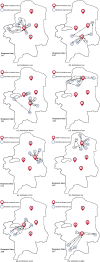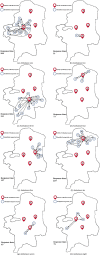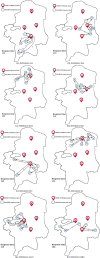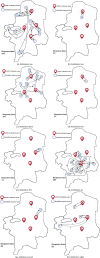Utilizing IoT to design a relief supply chain network for the SARS-COV-2 pandemic
- PMID: 33642961
- PMCID: PMC7902221
- DOI: 10.1016/j.asoc.2021.107210
Utilizing IoT to design a relief supply chain network for the SARS-COV-2 pandemic
Abstract
The current universally challenging SARS-COV-2 pandemic has transcended all the social, logical, economic, and mortal boundaries regarding global operations. Although myriad global societies tried to address this issue, most of the employed efforts seem superficial and failed to deal with the problem, especially in the healthcare sector. On the other hand, the Internet of Things (IoT) has enabled healthcare system for both better understanding of the patient's condition and appropriate monitoring in a remote fashion. However, there has always been a gap for utilizing this approach on the healthcare system especially in agitated condition of the pandemics. Therefore, in this study, we develop two innovative approaches to design a relief supply chain network is by using IoT to address multiple suspected cases during a pandemic like the SARS-COV-2 outbreak. The first approach (prioritizing approach) minimizes the maximum ambulances response time, while the second approach (allocating approach) minimizes the total critical response time. Each approach is validated and investigated utilizing several test problems and a real case in Iran as well. A set of efficient meta-heuristics and hybrid ones is developed to optimize the proposed models. The proposed approaches have shown their versatility in various harsh SARS-COV-2 pandemic situations being dealt with by managers. Finally, we compare the two proposed approaches in terms of response time and route optimization using a real case study in Iran. Implementing the proposed IoT-based methodology in three consecutive weeks, the results showed 35.54% decrease in the number of confirmed cases.
Keywords: COVID-19; Epidemic outbreaks; Industry 4.0; SARS-COV-2; Supply chain design.
© 2021 Elsevier B.V. All rights reserved.
Conflict of interest statement
The authors declare that they have no known competing financial interests or personal relationships that could have appeared to influence the work reported in this paper.
Figures
































Similar articles
-
Relief Supply Chain Management Using Internet of Things to Address COVID-19 Outbreak.Comput Ind Eng. 2021 May 28:107429. doi: 10.1016/j.cie.2021.107429. Online ahead of print. Comput Ind Eng. 2021. PMID: 34075271 Free PMC article.
-
Modelling Internet of things (IoT)-driven global sustainability in multi-tier agri-food supply chain under natural epidemic outbreaks.Environ Sci Pollut Res Int. 2021 Apr;28(13):16633-16654. doi: 10.1007/s11356-020-11676-1. Epub 2021 Jan 3. Environ Sci Pollut Res Int. 2021. PMID: 33389466 Free PMC article.
-
Study on IoT for SARS-CoV-2 with healthcare: present and future perspective.Math Biosci Eng. 2021 Nov 4;18(6):9697-9726. doi: 10.3934/mbe.2021475. Math Biosci Eng. 2021. PMID: 34814364 Review.
-
Drivers and Barriers to Implementing the Internet of Things in the Health Care Supply Chain: Mixed Methods Multicase Study.J Med Internet Res. 2023 Sep 20;25:e48730. doi: 10.2196/48730. J Med Internet Res. 2023. PMID: 37728990 Free PMC article.
-
Application of cognitive Internet of Medical Things for COVID-19 pandemic.Diabetes Metab Syndr. 2020 Sep-Oct;14(5):911-915. doi: 10.1016/j.dsx.2020.06.014. Epub 2020 Jun 11. Diabetes Metab Syndr. 2020. PMID: 32570016 Free PMC article. Review.
Cited by
-
Using network data envelopment analysis to assess the sustainability and resilience of healthcare supply chains in response to the COVID-19 pandemic.Ann Oper Res. 2022 Oct 21:1-44. doi: 10.1007/s10479-022-05020-8. Online ahead of print. Ann Oper Res. 2022. PMID: 36312207 Free PMC article.
-
A socio-economic optimization model for blood supply chain network design during the COVID-19 pandemic: An interactive possibilistic programming approach for a real case study.Socioecon Plann Sci. 2023 Feb;85:101439. doi: 10.1016/j.seps.2022.101439. Epub 2022 Sep 22. Socioecon Plann Sci. 2023. PMID: 36164508 Free PMC article.
-
Disaster relief supply chain design for personal protection equipment during the COVID-19 pandemic.Appl Soft Comput. 2021 Nov;112:107809. doi: 10.1016/j.asoc.2021.107809. Epub 2021 Aug 18. Appl Soft Comput. 2021. PMID: 34421442 Free PMC article.
-
Designing a new sustainable Test Kit supply chain network utilizing Internet of Things.Eng Appl Artif Intell. 2023 Sep;124:106585. doi: 10.1016/j.engappai.2023.106585. Epub 2023 Jun 21. Eng Appl Artif Intell. 2023. PMID: 37362906 Free PMC article.
-
Emergency medical service interventions and experiences during pandemics: A scoping review.PLoS One. 2024 Aug 1;19(8):e0304672. doi: 10.1371/journal.pone.0304672. eCollection 2024. PLoS One. 2024. PMID: 39088585 Free PMC article.
References
-
- Hajiaghaei-Keshteli M., Sajadifar S.M., Haji R. Determination of the economical policy of a three-echelon inventory system with (R,Q) ordering policy and information sharing. Int. J. Adv. Manuf. Technol. 2011;55(5–8):831–841.
LinkOut - more resources
Full Text Sources
Other Literature Sources
Miscellaneous
